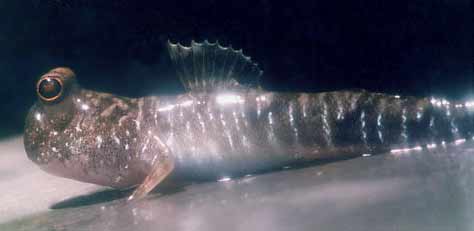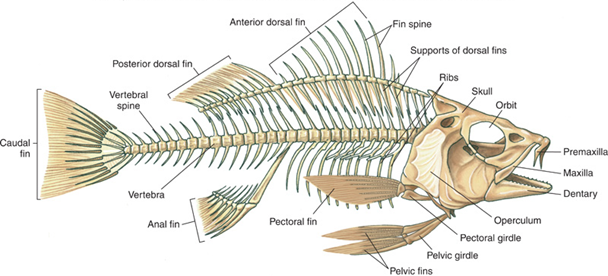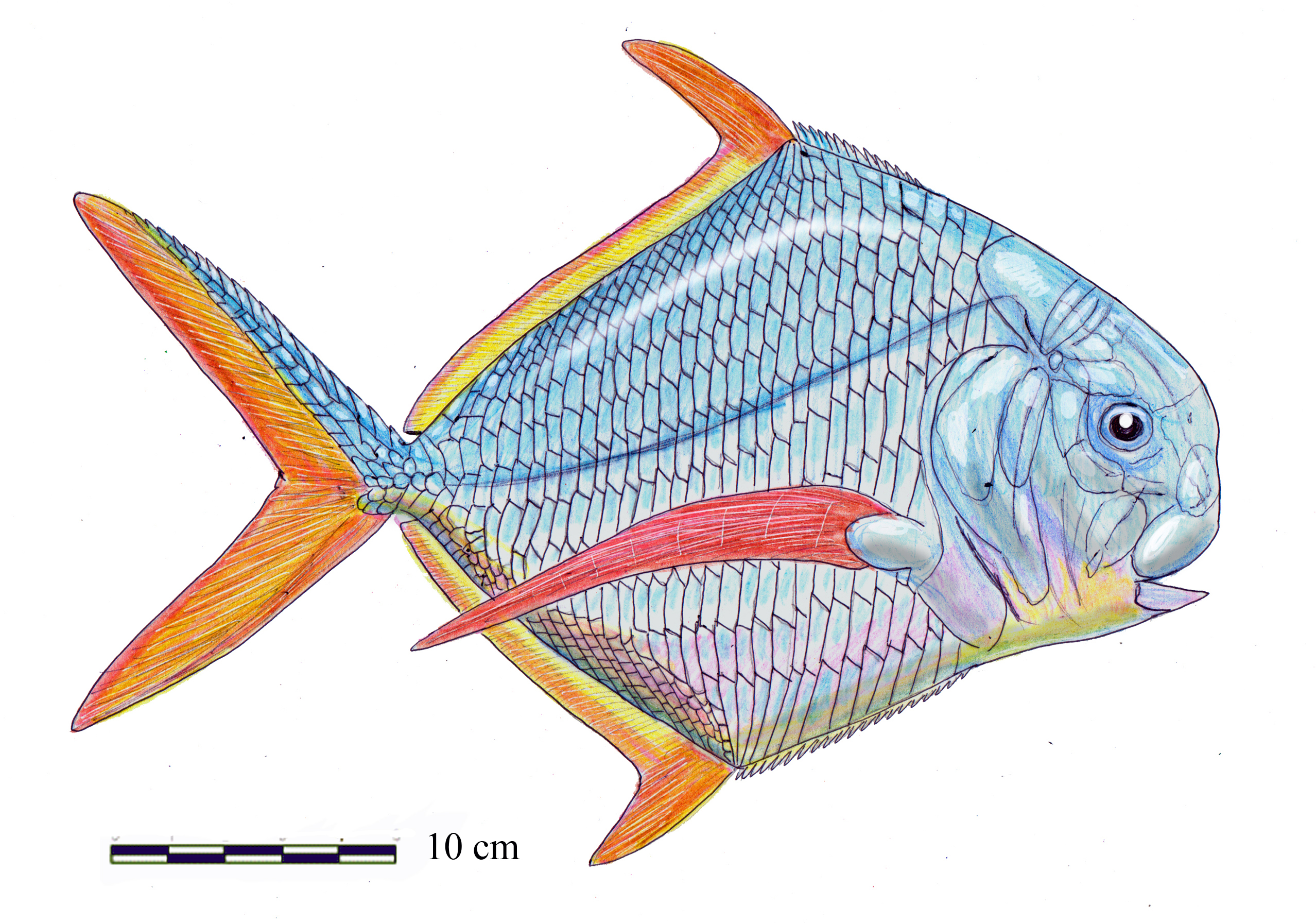|
Caudal Fin
Fins are distinctive anatomical features composed of bony spines or rays protruding from the body of a fish. They are covered with skin and joined together either in a webbed fashion, as seen in most bony fish, or similar to a flipper, as seen in sharks. Apart from the tail or caudal fin, fish fins have no direct connection with the spine and are supported only by muscles. Their principal function is to help the fish swim. Fins located in different places on the fish serve different purposes such as moving forward, turning, keeping an upright position or stopping. Most fish use fins when swimming, flying fish use pectoral fins for gliding, and frogfish use them for crawling. Fins can also be used for other purposes; male sharks and mosquitofish use a modified fin to deliver sperm, thresher sharks use their caudal fin to stun prey, reef stonefish have spines in their dorsal fins that inject venom, anglerfish use the first spine of their dorsal fin like a fishing rod ... [...More Info...] [...Related Items...] OR: [Wikipedia] [Google] [Baidu] |
Lampanyctodes Hectoris (fins)
Hector's lanternfish (''Lampanyctodes hectoris'') is a lanternfish in the family Myctophidae, the only species in the genus ''Lampanyctodes''. It is named after James Hector. It is a widespread marine fish, known from shallow tropical waters in the south-eastern Atlantic, from the western Pacific off Australia and New Zealand, and from the eastern Pacific off Chile. It is one of the few species of lanternfishes to inhabit shallow waters, and in those waters it is one of the most abundant species of fish, and central to the food chain of the upper continental slope. The abundance is due to its high fecundity — it spawns multiple times in the winter so that the fry can take advantage of the spring bloom of krill. It grows up to standard length (SL) and may reach the age of 3 years. It reaches sexual maturity at approximately 50 mm SL and age of one year. Hector's lanternfish is fished commercially using Seine fishing, seine nets in the waters off South Africa, where catches ... [...More Info...] [...Related Items...] OR: [Wikipedia] [Google] [Baidu] |
Anglerfish
The anglerfish are fish of the teleost order Lophiiformes (). They are bony fish named for their characteristic mode of predation, in which a modified luminescent fin ray (the esca or illicium) acts as a lure for other fish. The luminescence comes from symbiotic bacteria, which are thought to be acquired from seawater, that dwell in and around the sea. Some anglerfish are notable for extreme sexual dimorphism and sexual symbiosis of the small male with the much larger female, seen in the suborder Ceratioidei, the deep sea anglerfish. In these species, males may be several orders of magnitude smaller than females. Anglerfish occur worldwide. Some are pelagic (dwelling away from the sea floor), while others are benthic (dwelling close to the sea floor). Some live in the deep sea (such as the Ceratiidae), while others on the continental shelf, such as the frogfishes and the Lophiidae (monkfish or goosefish). Pelagic forms are most often laterally compressed, whereas the b ... [...More Info...] [...Related Items...] OR: [Wikipedia] [Google] [Baidu] |
Mudskipper
Mudskippers are any of the 23 extant species of amphibious fish from the subfamily Oxudercinae of the goby family Oxudercidae. They are known for their unusual body shapes, preferences for semiaquatic habitats, limited terrestrial locomotion and jumping, and the ability to survive prolonged periods of time both in and out of water. Mudskippers can grow up to long, and most are a brownish green colour that range anywhere from dark to light. During mating seasons, the males will also develop brightly coloured spots in order to attract females, which can be red, green or blue. Unlike other fish, the mudskipper's eyes protrude from the top of its flat head. Their most noticeable feature however is their side pectoral fins that are located more forward and under their elongated body. These fins are jointed and function similarly to limbs, which allow the mudskipper to crawl from place to place. Although having the typical body form of any other gobiid fish, these front fins all ... [...More Info...] [...Related Items...] OR: [Wikipedia] [Google] [Baidu] |
Fish Locomotion
Fish locomotion is the various types of animal locomotion used by fish, principally by swimming. This is achieved in different groups of fish by a variety of mechanisms of propulsion, most often by wave-like lateral flexions of the fish's body and tail in water, and in various specialised fish by motions of the fins. The major forms of locomotion in fish are: * Anguilliform, in which a wave passes evenly along a long slender body; * Sub-carangiform, in which the wave increases quickly in amplitude towards the tail; * Carangiform, in which the wave is concentrated near the tail, which oscillates rapidly; * Thunniform, rapid swimming with a large powerful crescent-shaped tail; and * Ostraciiform, with almost no oscillation except of the tail fin. More specialized fish include movement by pectoral fins with a mainly stiff body, opposed sculling with dorsal and anal fins, as in the sunfish; and movement by propagating a wave along the long fins with a motionless body, as in the k ... [...More Info...] [...Related Items...] OR: [Wikipedia] [Google] [Baidu] |
Dynamic Lift (fish)
Fish locomotion is the various types of animal locomotion used by fish, principally by swimming. This is achieved in different groups of fish by a variety of mechanisms of propulsion, most often by wave-like lateral flexions of the fish's body and tail in water, and in various specialised fish by motions of the fins. The major forms of locomotion in fish are: * Anguilliform, in which a wave passes evenly along a long slender body; * Sub-carangiform, in which the wave increases quickly in amplitude towards the tail; * Carangiform, in which the wave is concentrated near the tail, which oscillates rapidly; * Thunniform, rapid swimming with a large powerful crescent-shaped tail; and * Ostraciiform, with almost no oscillation except of the tail fin. More specialized fish include movement by pectoral fins with a mainly stiff body, opposed sculling with dorsal and anal fins, as in the sunfish; and movement by propagating a wave along the long fins with a motionless body, as in the k ... [...More Info...] [...Related Items...] OR: [Wikipedia] [Google] [Baidu] |
Tetrapod
Tetrapods (; ) are four-limbed vertebrate animals constituting the superclass Tetrapoda (). It includes extant and extinct amphibians, sauropsids ( reptiles, including dinosaurs and therefore birds) and synapsids ( pelycosaurs, extinct therapsids and all extant mammals). Tetrapods evolved from a clade of primitive semiaquatic animals known as the Tetrapodomorpha which, in turn, evolved from ancient lobe-finned fish (sarcopterygians) around 390 million years ago in the Middle Devonian period; their forms were transitional between lobe-finned fishes and true four-limbed tetrapods. Limbed vertebrates (tetrapods in the broad sense of the word) are first known from Middle Devonian trackways, and body fossils became common near the end of the Late Devonian but these were all aquatic. The first crown-tetrapods ( last common ancestors of extant tetrapods capable of terrestrial locomotion) appeared by the very early Carboniferous, 350 million years ago. The specific aquat ... [...More Info...] [...Related Items...] OR: [Wikipedia] [Google] [Baidu] |
Homology (biology)
In biology, homology is similarity due to shared ancestry between a pair of structures or genes in different taxa. A common example of homologous structures is the forelimbs of vertebrates, where the wings of bats and birds, the arms of primates, the front flippers of whales and the forelegs of four-legged vertebrates like dogs and crocodiles are all derived from the same ancestral tetrapod structure. Evolutionary biology explains homologous structures adapted to different purposes as the result of descent with modification from a common ancestor. The term was first applied to biology in a non-evolutionary context by the anatomist Richard Owen in 1843. Homology was later explained by Charles Darwin's theory of evolution in 1859, but had been observed before this, from Aristotle onwards, and it was explicitly analysed by Pierre Belon in 1555. In developmental biology, organs that developed in the embryo in the same manner and from similar origins, such as from matching prim ... [...More Info...] [...Related Items...] OR: [Wikipedia] [Google] [Baidu] |
Kopie Van DSC00282
Kopie is a village in the administrative district of Gmina Godziesze Wielkie, within Kalisz County, Greater Poland Voivodeship Greater Poland Voivodeship ( pl, Województwo wielkopolskie; ), also known as Wielkopolska Voivodeship, Wielkopolska Province, or Greater Poland Province, is a voivodeship, or province, in west-central Poland. It was created on 1 January 1999 ..., in west-central Poland. References Kopie {{Kalisz-geo-stub ... [...More Info...] [...Related Items...] OR: [Wikipedia] [Google] [Baidu] |
Acanthodii
Acanthodii or acanthodians is an extinct class of gnathostomes (jawed fishes), typically considered a paraphyletic group. They are currently considered to represent a grade of various fish lineages leading up to the extant Chondrichthyes, which includes living sharks, rays, and chimaeras. Acanthodians possess a mosaic of features shared with both osteichthyans (bony fish) and chondrichthyans (cartilaginous fish). In general body shape, they were similar to modern sharks, but their epidermis was covered with tiny rhomboid platelets like the scales of holosteians ( gars, bowfins). A lower Silurian species, ''Fanjingshania renovata'', attributed to Climatiiformes is the oldest chondrichthyan with known anatomical features. The popular name "spiny sharks" is because they were superficially shark-shaped, with a streamlined body, paired fins, a strongly upturned tail, and stout, largely immovable bony spines supporting all the fins except the tail—hence, "spiny sharks". Howev ... [...More Info...] [...Related Items...] OR: [Wikipedia] [Google] [Baidu] |
Clades
A clade (), also known as a monophyletic group or natural group, is a group of organisms that are monophyletic – that is, composed of a common ancestor and all its lineal descendants – on a phylogenetic tree. Rather than the English term, the equivalent Latin term ''cladus'' (plural ''cladi'') is often used in taxonomical literature. The common ancestor may be an individual, a population, or a species ( extinct or extant). Clades are nested, one in another, as each branch in turn splits into smaller branches. These splits reflect evolutionary history as populations diverged and evolved independently. Clades are termed monophyletic (Greek: "one clan") groups. Over the last few decades, the cladistic approach has revolutionized biological classification and revealed surprising evolutionary relationships among organisms. Increasingly, taxonomists try to avoid naming taxa that are not clades; that is, taxa that are not monophyletic. Some of the relationships between organis ... [...More Info...] [...Related Items...] OR: [Wikipedia] [Google] [Baidu] |
Ocean Sunfish
The ocean sunfish or common mola (''Mola mola'') is one of the largest bony fish in the world. It was misidentified as the heaviest bony fish, which was actually a different species, ''Mola alexandrini''. Adults typically weigh between . The species is native to tropical and temperate waters around the world. It resembles a fish head without a tail, and its main body is flattened laterally. Sunfish can be as tall as they are long when their dorsal and ventral fins are extended. Sunfish are generalist predators that consume largely small fish, fish larvae, squid, and crustaceans. Sea jellies and salps, once thought to be the primary prey of sunfish, make up only 15% of a sunfish's diet. Females of the species can produce more eggs than any other known vertebrate, up to 300,000,000 at a time. Sunfish fry resemble miniature pufferfish, with large pectoral fins, a tail fin, and body spines uncharacteristic of adult sunfish. Adult sunfish are vulnerable to few natural predators, b ... [...More Info...] [...Related Items...] OR: [Wikipedia] [Google] [Baidu] |
Bobasatrania
''Bobasatrania'' is an extinct genus of prehistoric bony fish that survived the Permian-Triassic extinction event. Fossils of ''Bobasatrania'' were found in beds of Changhsingian (late Permian) to Ladinian (Middle Triassic) age. It was most speciose during the Early Triassic. The genus was named after the locality Bobasatrana in northeast Madagascar, from where the type species was described. The genus originated during the late Permian, survived the Permian-Triassic extinction event, and underwent a speciation event during the Triassic (approx 240M years BP) in the shallow coastal waters off the Pangaean supercontinent. Their fossils are therefore found throughout the world, with some of the best examples coming from the Wapiti Lake region of British Columbia, Canada. Past Lives: Chronicles of Canadian Paleontology They have a distinctive diamond-shaped body, forked tail and long thin pectoral fins. The larger species are up to in length, though there are also smaller ... [...More Info...] [...Related Items...] OR: [Wikipedia] [Google] [Baidu] |
.png)






